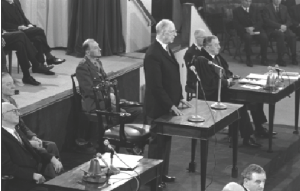Angry protests greet de Valera’s last address to the Oireachtas
Published in Issue 1 (January/February 2014), News, Volume 22
President Eamon de Valera addressing the joint houses of the Oireachtas in the Mansion House on 21 January 1969 and Joe Clarke
De Valera’s return to the Oireachtas was in the context of the ceremonies to mark the golden jubilee of the first meeting of Dáil Éireann, which had sat for the first time on 21 January 1919. Following consultations with the government and the council of state, it was agreed that President de Valera would address a specially convened joint sitting of the Dáil and Seanad (the first president of Ireland to do so) in the Mansion House, the venue in which the original Dáil had met, 50 years to the day after the historic first meeting.
De Valera’s address to the Oireachtas had been envisaged as the centrepiece of a national day of celebration, but what transpired was very different. The streets of Dublin witnessed scenes of angry protest and public disorder. Meanwhile, the president suffered the indignity of being heckled in the course of his remarks to the members of the Dáil and Seanad. The joint sitting in the Mansion House was attended by 750 invited guests, including the surviving members of the First Dáil, relatives of the 1916 leaders, civic and church dignitaries and members of the diplomatic corps.
The president spoke entirely in Irish and the substance of his remarks was largely commemorative. In particular, de Valera praised his old comrade Seán MacEntee, who was a member of the First Dáil and remained a TD in 1969. He veered briefly into the domain of politics when he warned of the dangers of ‘cosmopolitanism’, reflecting his concerns that Ireland’s distinct national identity could be diluted by EEC membership. De Valera’s appeal to ‘small nations’ to guard against being ‘brushed aside or absorbed by great powers’ was largely overshadowed by a series of protests by the Dublin Housing Action Committee (DHAC), which had deliberately targeted the ceremonies marking the anniversary of the First Dáil.
The DHAC had been formed in May 1967 and was engaged in a militant campaign to alleviate the chronic housing shortages in the capital. Leading Sinn Féin figures such as Proinsias de Rossa and Máirín de Burca were prominent, but the organisation was not merely a republican front. Its membership was a broad church of left-wing activists and included figures from the Labour Party, the Communist Party of Ireland and other fringe radical groups. In the days preceding de Valera’s address, the DHAC put pressure on the Labour Party to walk out of the Mansion House ceremonies as a response to the robust manner in which gardaí had dealt with DHAC members, who had staged a sit-down protest on O’Connell Bridge on 18 January 1969. The Labour leader, Brendan Corish, ignored this call.
The DHAC, in the words of Tony Gregory’s biographer Robbie Gilligan, was ‘very adept in the use of high-profile actions calculated to get publicity for their cause’. The DHAC planned to interrupt the president’s speech in order to draw attention to the plight of one of its activists, Denis Dennehy, who was on hunger strike in Mountjoy prison. Dennehy, who was also a member of the Irish Communist Organisation, had been imprisoned for squatting in a flat in Mountjoy Square.
Joe Clarke, a veteran Sinn Féin leader who had actually fought directly under de Valera’s command in 1916, had managed to secure an invitation to sit among the distinguished visitors at the Mansion House because he had been usher-in-charge in the First Dáil. Clarke was determined to disrupt the Oireachtas proceedings in support of the DHAC. The Irish Times reported the following day that Clarke heckled the president and
‘. . . leaning on his crutches interjected the following into the staid proceedings hitherto carried out in Gaelic: “The programme of the old Dáil has never been implemented. This is a mockery. There are people on hunger strike in Mountjoy. The housing of the people . . .”. Dáil Éireann ushers grappled with the disabled veteran. They moved him to the outer door. There, it transpires, they gave him his crutches and released him . . . Mr de Valera carried on as if unhearing.’

Joe Clarke, who served under de Valera in 1916, being ejected by ushers following his interjection. (RTÉ Stills Library; An Phoblacht)
Outside the Mansion House, a crowd estimated at 3,000 chanted ‘Occupy, occupy, occupy’. Hundreds of gardaí patrolled the streets of Dublin and protected strategic buildings. The DHAC organised a picket of the GPO and a march to Mountjoy prison. A mock trial outside the GPO found all those attending the Mansion House ceremonies guilty for their failure to implement the Democratic Programme of the First Dáil. Ten protestors were arrested for breaches of the peace.
The day of protest that accompanied the first address by a president of Ireland to the Oireachtas was neatly captured by the Irish Times’s political reporter, who observed:
‘During the celebrations the President met the British ambassador, Sir Andrew Gilchrist. They shook hands and the ambassador said “Mr President, I want you to realise that this time the British are with you”. Which made it more interesting that some of the Irish without the walls were not.’
It was a sad end to Dev’s long parliamentary career. HI
Brian Murphy has recently submitted his Ph.D thesis in the School of History and Archives, University College Dublin.
















